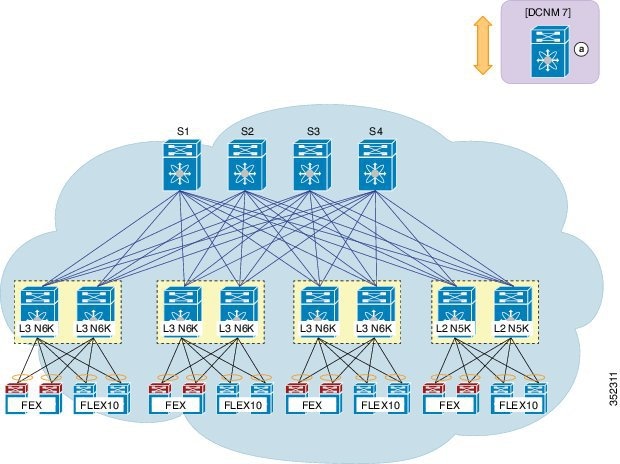Migration Overview
This chapter contains the following sections:
- Prerequisites
- Limitations
- Existing FabricPath Topology
- Cisco Dynamic Fabric Automation Topology
- Traffic Flow Before and After Migration
Prerequisites
To prepare for migration to the Cisco DFA solution, you must meet the following prerequisites.
-
Deploy and configure Cisco Prime Data Center Network Manager 7.0
-
FabricPath on Spine-Leaf Topology
-
Cisco Nexus 7000 Series spine switches with Cisco NX-OS 6.2(2)
-
Cisco Nexus 6000 Series border leaf switches with Cisco NX-OS 6.02.N2
-
Cisco Nexus 6000 Series leaf switches with Cisco NX-OS 6.02.N2 images

Note
It is recommended to replace all the non-Cisco DFA device with Cisco Nexus 6000 Series switches with Cisco NX-OS version 7.0(0)N1(1) or later.
-
Cisco Nexus 1000V Series virtual switches at the virtual machine access layer
-
Limitations
Following are some of the limitations:
-
Only legacy multicast is supported with Cisco Nexus 5500 Platform in DFA topology
-
Enhanced fabric multicast is supported if DFA topology consists only of Cisco Nexus 6000 Series Switches
-
The border leaf pair configuration is manual and no border leaf auto DCI configuration is supported until the topology has been fully migrated to DFA-capable nodes
-
Any hosts behind border leaf are not supported
-
Anchor leaf is always a border leaf and must be manually configured
-
We can exit from migration mode only after all Cisco Nexus 5000 Series Switches are upgraded to Cisco Nexus 6000 Series Switches or Cisco Nexus 5600 Platform then write erase POAP via DCNM on border leaf can be done to support BL-DCI auto-configuration
Existing FabricPath Topology
You must have this existing FabricPath topology before you can migrate to Cisco DFA.
-
An access layer with FabricPath-enabled virtual port channel (vPC) peers (vPC+)
-
Layer-3 aggregation layer-only connection to Spine layers
-
At least one VPC+ pair, border leaf, for anchoring VLAN SVIs
-
Switched Virtual Interfaces (SVIs) on only one set of vPC+ peers
-
The Hot Standby Router Protocol (HSRP) running in local Layer-3 VLANs
 Note | Anchor leaf is supported only on border leaf. |
Cisco Dynamic Fabric Automation Topology
The Cisco DFA fabric with both Cisco Nexus 5000 and 6000 Series leaf nodes includes the following:
-
Cisco Nexus 5000 Series remains as Layer-2
-
Spine switches that can forward both 1q and 2q traffic, encapsulated in a FabricPath header
-
VLAN/SVI differences are as follows: -
On a Cisco Nexus 5000 Series Switches involved VLAN/SVI: segment IDs are not enabled on all leaf nodes for VLANs configured on Cisco Nexus 5000 Series leaf nodes. Border leaf runs HSRP/Virtual Router Redundancy Protocol as well as anycast gateway mode.
-
VLAN/SVIs with full DFA-leaf nodes only can be segment ID-enabled. The forwarding mode can be either proxy or anycast gateway mode.
-
Multicast will continue to run in the legacy multicast mode. Cisco DFA multicast should not be enabled.
-
The following figure shows the DFA fabric with Cisco Nexus 5000 and 6000 Series leaf nodes.

The DFA fabric with only Cisco Nexus 6000 Series leaf nodes includes the following:
-
Cisco Nexus 6000 Series leaf nodes that run either anycast gateway mode or proxy gateway mode
-
Spine switches that can forward both 1q and 2q traffic, encapsulated in a FabricPath header
-
All VLANs can be segment ID enabled
The following figures show the DFA fabric with only Cisco Nexus 6000 Series leaf nodes.

Traffic Flow Before and After Migration
As a result of changes to the topology and configuration of switches, the traffic flow is optimized after the migration. Traffic flow differences are shown in the following set of figures.







 Feedback
Feedback